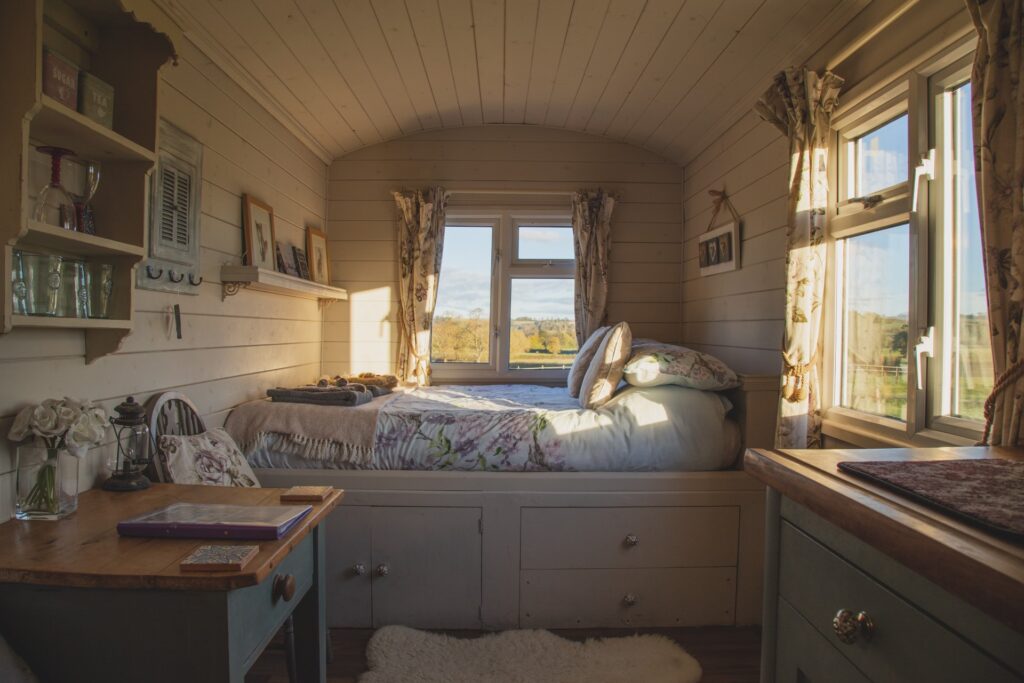
We are reader-supported. When you buy through links on our site, we may earn an affiliate commission.
Does the hustle, bustle and noise of modern society weigh on you like Jacob Marley’s chains? If so, getting away from civilization by building an off-grid tiny home may delight your sensibilities. There’s more to the endeavor than erecting a shed, however.
You need to find a suitable location that permits the building of such structures. Since you won’t connect to city services, you’ll need to arrange for sustainable light, heat and water. If you want to minimize time-consuming trips to town, you’ll also require a way to supply food.
Locate Suitable Land
To go off the grid with your tiny home, you’ll need to scope rural land. If you are new to the buying process, find a competent real estate agent and describe your plans. Be specific in your instructions — many remote areas have no restrictions yet, but some regions do prohibit tiny homes in their building codes.
Exercise caution when investigating “for sale by owner” listings. Some owners have no sincere interest in selling, but they list their property to get a free appraisal and consider their future options. A buyer’s agent should verify the intent and won’t waste your time with unavailable plots. After all, it can take hours to drive to some locations — that’s a ton of time and gas.
Research Building and Zoning Codes
Before you sign any dotted lines or part with cash, learn the difference between building and zoning codes and how each affects property use. In essence, zoning deals with how you may use the land, and building codes specify details of the structure itself — such as the accessibility of bathrooms.
Let’s say you intend to establish an off-grid community for formerly homeless individuals. Zoning ordinances will impact if you can use the land for this worthy goal. Building codes, conversely, may state that any facility used for such a purpose must have at least one bathroom that’s 70 square feet or larger. If such conditions exist, you’ll need to build one more traditional single-family residence and classify the tiny homes as accessory structures.
Establish Independent Utilities
Since you aren’t connected to traditional services, you need to determine how you’ll take a bath and see at night. If you want to go for the “Grizzly Adams” experience, you can make do with a rain barrel, solar shower, woodstove and lanterns. However, if you don’t get any precipitation, things could get thirsty. You’ll probably want to invest in the following:
- A well and septic tank: If you live in an arid region, drilling a well can add tens of thousands to your overall cost because of the need to dig deep to locate aquifers.
- Solar and generator power: Fortunately, you have a host of solar options, from roofing to cladding. You can even find portable units. Make sure you have an ample storage battery. Even still, it’s always wise to have a backup generator.
- Communications: You fall and twist your ankle in a gopher hole while hoeing the garden. How will you call for help? Even if you don’t need a traditional phone and internet service, you’ll want some way — like a satellite radio — to communicate if you need aid.
Decide If On or Off-Site Building Is Best
One option you have is to build your off-grid tiny home on your selected site. Doing so simplifies the process of pouring the foundation and attaching the rest of the structure. However, you’ll need an RV for living comfort unless you can hack it in a tent for an extended time.
Another choice involves building a tiny home on wheels and transporting it to your property. You’ll need a suitable location to perform the construction, and a truck with a gooseneck or 5th wheel hitch to transport the finished product. The advantage of this method is that you can begin erecting the structure before you locate a plot.
Erect a Greenhouse and Hoe the Back 40
If you plan on making weekly trips to town for provisions, you won’t have to worry about much more than stocking up before blizzards arrive. However, if you want to minimize contact with the outside world, you’ll need a sizable garden plot and a greenhouse for year-round growing.
This endeavor need not cost a ton. If you are going off-grid for ecological reasons, you can build a greenhouse from used windows or plastic bottles — reuse and recycle, baby. Plastic sheeting is less eco-friendly, but it does offer a quick alternative if old man winter makes an early appearance.
Build Your Ultimate Off-Grid Tiny Home
Building an off-grid tiny home involves numerous steps. By following the above approach, you can enjoy the best of living off the land’s bounty.










